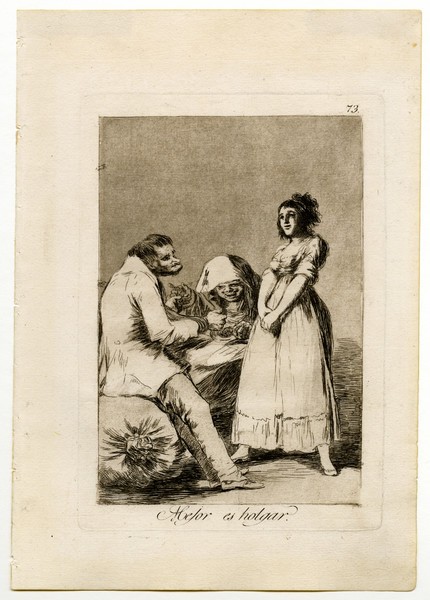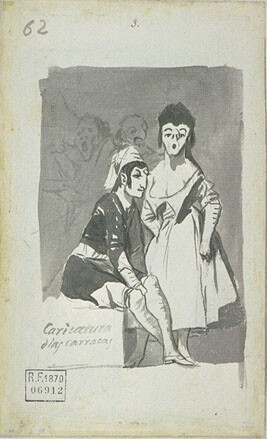- Cronología
- Ca. 1797 - 1799
- Dimensiones
- 217 x 152 mm
- Técnica y soporte
- Aguafuerte, aguatinta bruñida, punta seca y buril
- Reconocimiento de la autoría de Goya
- Undisputed work
- Ficha: realización/revisión
- 12 Jan 2011 / 29 May 2024
- Inventario
- 225
Mejor es holgar. (at the bottom)
73. (in the upper right-hand corner)
See Francisco de Goya y Lucientes, Painter.
A proof of its condition prior to the drypoint is preserved in the Prado Museum. The title is the same as the one written by hand on the final print, although Goya thought of an earlier one that has been crossed out: que te cansas?
A young woman with her feet apart stands in front of a toothless old man with a prominent chin who is seated on a large sack. The young woman holds a ball of wool in her hands and rests it on her lap in a gesture that has clearly erotic connotations. Between the two, in the background, there is an old woman seated between them, holding a skein of yarn, which could be suggesting the relationship between the man and the young woman.
Ayala's manuscript explains this engraving as follows: "Women want more to lie down at the bribia, than to unravel skeins and work at home", while that in the Prado National Museum notes: "If the one who works is the one who enjoys the least, he is right, it is better to smell". The most detailed explanation is that of the Biblioteca Nacional; in the engraving it is interpreted in these words: "A vicious family is hardly subject to honest home occupations. The husband's beastly husband gets tangled up in the skein; the mother-in-law untangles it and the wife gets tired and shows in her gestures that it is more important for her to go to the rascal".
The content of this engraving is quite clear: it is a criticism of prostitution, to which many women resorted in order to make a living. The old woman in the centre of the composition weaves a link between the two, she is the one who has plotted the origin of this relationship. The young woman will agree to join the man despite his unpleasant appearance for purely economic reasons.
The aquatint of this engraving is rather weakened (National Chalcography, no. 244).
-
Goya. Gemälde Zeichnungen. Graphik. TapisserienKunsthalle BaselBasle1953from January 23th to April 12th 1953cat. 252
-
Goya. La década de Los CaprichosMadrid1992organized by Real Academia de Bellas Artes de San Fernando sponsored by Fundación Central Hispano, Madrid, consultant editor Nigel Glendinnig. From October 26th 1992 to January 10th 1993cat. 157
-
Francisco de GoyaMuseo d'Arte ModernaLugano1996exhibition celebrated from September 22nd to November 17th.cat. 73, p.100
-
Francisco Goya. Sein leben im spiegel der graphik. Fuendetodos 1746-1828 Bordeaux. 1746-1996Galerie KornfeldBern1996from November 21st 1996 to January 1997cat. 79
-
Goya e la tradizione italianaFondazione Magnani RoccaMamiano di Traversetolo (Parma)2006consultant editors Fred Licht and Simona Tosini Pizzetti. From September 9th to December 3th 2006cat. 73, p.164
-
Goya. Opera graficaPinacoteca del Castello di San GiorgioLegnano2006exhibition celebrated from December 16th 2006 to April 1st 2007p.43
-
Goya et la modernitéPinacothèque de ParisParís2013from October 11st 2013 to March 16th 2014cat. 200
-
2022
-
Goya engravings and lithographs, vol. I y II.OxfordBruno Cassirer1964p.151, cat. 108
-
Vie et ouvre de Francisco de GoyaParísOffice du livre1970p.184, cat. 599
-
Goya, la década de los caprichos: dibujos y aguafuertesMadridReal Academia de Bellas Artes de San Fernando1992pp.259-261, cat. 157-158
-
Catálogo de las estampas de Goya en la Biblioteca NacionalMadridMinisterio de Educación y Cultura, Biblioteca Nacional1996p.113, cat. 165
-
El libro de los caprichos: dos siglos de interpretaciones (1799-1999). Catálogo de los dibujos, pruebas de estado, láminas de cobre y estampas de la primera ediciónMadridMuseo Nacional del Prado1999pp.364-367
-
ParísPinacoteca de París2013p. 266
-
Goya. In the Norton Simon MuseumPasadenaNorton Simon Museum2016pp. 42-75
-
Museo de Bellas Artes de Badajoz y Diputación de Badajoz2022p. 50

